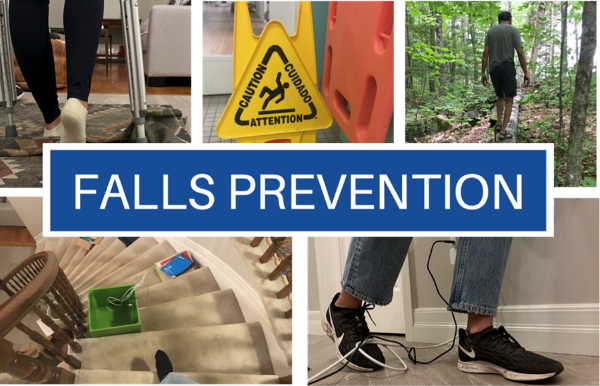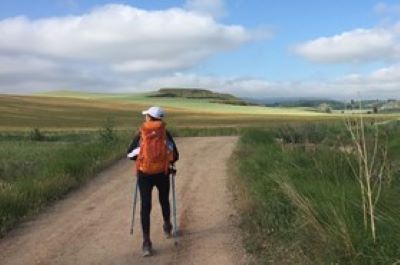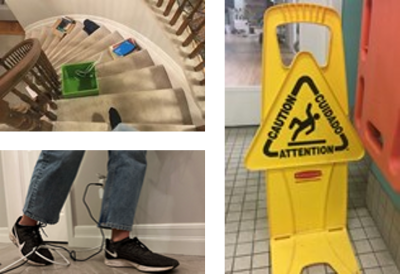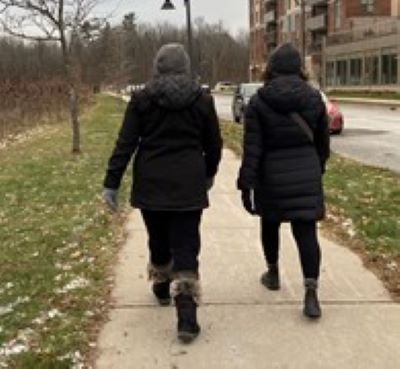
Don’t Let Falling Get You Down: Falls prevention strategies
Are you worried about falling? Does your fear of falling prevent you from doing the things you love?
In Canada, falls are the most common cause of injury in older adults estimating that between 20-30% of adults over the age of 65 experience a fall each year. These injuries, rightfully so, can lead to anxiety about falling, resulting in a fear of experiencing another fall. This unfortunately, creates a vicious cycle of reduced movement, loss of strength, and worsening balance, thus impacting your ability to walk safely, placing you at an even higher risk of a future fall.
This post will go over:
- What is fear of falling and why it increases your risk of falling
- What causes a fall
- Video exercises to help build strength and balance
- Who can help you reduce your risk of falling
What is Fear of Falling?
In general, fear of falling is an ongoing concern of falling that ultimately limits your ability to perform your daily activities. Now unfortunately, even if you’ve never experienced a fall first hand, you may still have a fear of falling. This fear can lead to reduced mobility and strength and limit your overall function, which puts you at a higher risk of experiencing a fall in the future.
One of the best ways to reduce your risk of falling is to keep active and keep moving. Maintaining your strength and balance, as you get older can benefit you in various ways allowing you to continue your day-to-day life independently.

What causes a fall?
Personal factors:
- Decreased strength
- Reduced balance
- Visual changes
- History of falls
- Cognitive problems
- Lack of sleep
- Impulsivity or in a rush
- Depression/anxiety
- Medications (speak with your doctor about possible side effects)
- Alcohol consumption/ substance abuse
Environmental factors:
Stairs
Throw rugs
Poor lighting
Slippery/wet floors
Inappropriate shoes
Improper walking aid
Clutter

How to reduce your risk of falling
In your home:
-
- Remove throw rugs
- Reduce clutter! Tuck away all wires and electrical cords
- Use a non-slip mat inside and outside your bath/shower
- Install grab-bars on your shower walls
- Install a grab-bar on the side of your bed to help you get in and out safely
- Proper lighting around your home
- Sit at the edge of your bed for 10 seconds to reduce dizziness
- Avoid socks on hardwood floors and stairs
- Install handrails on stairways and never rush going up or down
- Keep frequently used items in an easy to reach spot
In the community:
-
- Wearing supportive shoes outside
- Keep your eyes open, take a minute to look around your environment before you start walking
- Use your prescribed walking aide to improve your balance and allow you to walk longer distances
- Walk with a friend!

How to build your balance and strength
5 exercises to help improve your balance and strength
Perform 5 times, progress by using no hands
March in place for 30 seconds
Repeat 10 times
Hold wide step for 10 seconds
*Disclaimer: please be aware these exercises listed above are to be done at your own risk. It is recommended that you hold onto a secure object for support such as a counter.
Stand on one leg, tap your opposite leg in front, beside, and behind repeat three times per leg
Here is an important question…what happens when you fall?
Create a plan:
Of course, in an ideal world, no one would want to experience a fall, but if you live alone and feel you are at risk it may be a good idea to create a plan for yourself in case you fall.
- When falling, try your best to land on your buttock (I know easier said then done). After a fall, do not rush to get up, make sure you are not injured prior to standing.
- Now if you fall and are unable to get up, here is where your plan will come in handy. First thing is to call for help. This may mean reaching into your pocket and grabbing your phone or using a personal alarm system. It is important that you have discussed your plan with a friend, neighbour, or family member so they are aware you may be calling them for help.
- If you are unable to reach someone you know, dial 911 for assistance.
- If you are unable to reach your phone, calling out or banging on the nearest wall or floor may work.
- Have people check in with you – schedule frequent calls or visits with friends or family members.
- Always report falls to your health care provider to help you determine the cause and find ways to prevent another one.
- Most importantly don’t let the fear of falling stop you from enjoying an active lifestyle!
Who can help?
Seeing a physiotherapist, kinesiologist, athletic therapist or personal trainer can greatly reduce your risk of falling. They can evaluate your strength, balance, and walking mobility and provide you with the appropriate exercises and education to decrease your risk of falling.
Call LiquidGym today to book with one of our health professionals
to get you back to feeling great again!
613-820-8228
References:
Young W.R., Williams A.M. (2015) How fear of falling can increase fall-risk in older adults: Applying psychological theory to practical observations. Gait and Posture. 41(1), 7-12.
Pearson C., St-Arnaud J., Geran L.(2014).Statistics Canada. Understanding seniors’ risk of falling and their perception of risk. Retrieved from: https://www150.statcan.gc.ca/n1/pub/82-624-x/2014001/article/14010-eng.htm
National Institute on Aging (NIA) (2017). Prevent falls and fractures. Retrieved from: https://www.nia.nih.gov/health/prevent-falls-and-fractures
Author:
Alya Jaffer
Physiotherapy Resident